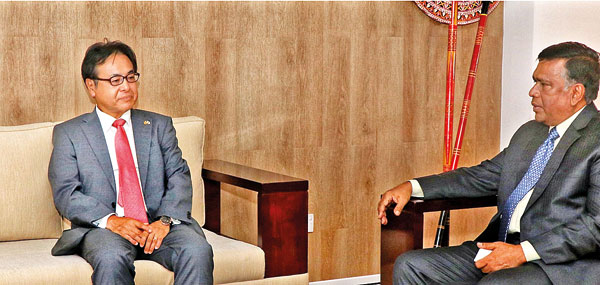News
More aid to help feed children and worst off district
View(s):By Kapila Bandara
UN humanitarian organisation, the World Food Programme, this week began handing out rice, lentils, and refined palm oil to 15,000 Sri Lankans in Nuwara Eliya, where poverty is highest, and Colombo.
This assistance, at a time when 6.3 million Sri Lankans are in hunger, is made possible by a donation worth US$1.5 million (Rs 540 million) by Japan to the WFP. The funds will also go to assist 380,000 school children through the national school meal programme.
The first portion of the commodities handed over Monday, is part of a consignment bought from overseas and imported as separate shipments.

Mizukoshi Hideaki, the ambassador of Japan in Sri Lanka, with Abdur Rahim Siddiqui, the WFP representative and country director, at the Ministry of Trade, Commerce and Food Security on August 29, 2022
The Ambassador of Japan to Sri Lanka, Mizukoshi Hideaki said in a statement, the essential food supplies, “will be delivered to vulnerable families and children’’.
WFP Representative and Country Director, Mr Abdur Rahim Siddiqui, said the Japanese Government was one of the first to promise support to an appeal by WFP. “The donation will go a long way in addressing Sri Lanka’s growing food insecurity.’’
At least 6.3 million, or every three in 10 Sri Lankans, are now getting by without an adequate diet. The prices of food are up by a record 90%. A kilo of red lentils, a staple, now costs Rs 580; a kilo of king mackerel (Thora) costs Rs 5,600.
The WFP and the UN Food and Agriculture Organization have found that about two-thirds of families are eating less, or less nutritious food. Pregnant and breastfeeding women, children below five years, and those less able, are among the worst affected. Data show, 15% of children are wasted (based on height-for-weight measurements), while 17% are stunted. Among adults, 34.6% of women in child-bearing age have anaemia.
More than 10,000 children are in institutional care due to poverty, Unicef has found. Sri Lanka also has the second-highest rate of acute malnutrition in children under five years in South Asia.
At some clinics for pregnant and breastfeeding mothers and young children, the Thriposha meant for them was stopped by the Government in January.
UN agencies have been the first to respond to an alarming situation.
The WFP began its emergency response in mid-June, just weeks after the Central Bank of Sri Lanka declared on April 12, a pre-emptive negotiated default of foreign debt. The price of food had jumped by 45% in April. That month, the price of red lentils had soared by 170% from 2021, and a white egg cost 69% more. On April 26, Litro Gas raised the price of a 12.5 kg cooking gas cylinder from Rs 2,675 to Rs 4,860. Nadu rice was selling for between Rs. 210 and Rs 230 a kilo then.
But, when the debt default was called, the global vegetable oil and cereal price indices had dropped by 5% and 0.5% from March. The price of wheat had increased.
Unicef launched its own appeal in June to raise US$25 million, saying 70% of households have reduced what they eat, and that 25 essential medicines for children and pregnant women could run out in two months.
Nuwara Eliya, where the WFP is distributing food, is the district with the highest multi-dimensional poverty, ahead of Badulla and Moneragala, Ratnapura, and Mannar, the top five. According to the Sri Lankan National Multidimensional Poverty Index, in Nuwara-Eliya, more than two-fifths, or 44.2% are in poverty.
The index by Unicef Sri Lanka, Oxford Poverty & Human Development Initiative, and the Department of Census and Statistics, is a policy tool and measures three key dimensions of poverty — education; health, and the standard of living. It evaluates 10 indicators — years of schooling; school attendance; chronic illness; access to health facilities; housing; sanitation; drinking water; cooking fuel; assets, and basic facilities.
A WFP spokesperson said the children are from Government schools across the country enrolled in the national school meal programme. The meals are prepared by parents or members of the community from within the school catchment area who have been selected by the Government. The meals are prepared according to a predetermined menu.
WFP has been supporting the national school meal programme since 2003.
In 2021, WFP bought maize to provide more than 1.3 million packets of Thriposha, when Sri Lanka wrestled the coronavirus disease which killed 14,962 that year.
In August, Norway gave 5 million Norwegian Krone (Rs 179.7 million) for life-saving assistance. In June, Australia provided A$22 million (Rs 5.3 billion)
The WFP needs US$63 million
funding.
The best way to say that you found the home of your dreams is by finding it on Hitad.lk. We have listings for apartments for sale or rent in Sri Lanka, no matter what locale you're looking for! Whether you live in Colombo, Galle, Kandy, Matara, Jaffna and more - we've got them all!

